Estimation of CO2 Emissions Embodied in Domestic Trade and Their Influencing Factors in Japan
Abstract
:1. Introduction
1.1. Background
1.2. Literature Review
1.2.1. CO2 emissions Embodied in Trade
1.2.2. Regional Carbon Transfers
1.3. Research Objective
1.4. Research Significance
2. Methodology and Data
2.1. CO2 Emissions Assessment Framework with Input–Output Model
2.2. Evaluation of Influencing Factors Using the LMDI Decomposition Approach
2.3. Data
3. Results and Discussion
3.1. The CO2 Emissions Embodied in Japan’s Domestic Trade
3.2. Carbon Transfer Path of Domestic Imports between Prefectures
3.3. The Influencing Factors of Net Export CO2 Emissions across Prefectures
3.4. Limitations of the Study
4. Conclusions and Policy Implications
Author Contributions
Funding
Institutional Review Board Statement
Informed Consent Statement
Data Availability Statement
Conflicts of Interest
Appendix A
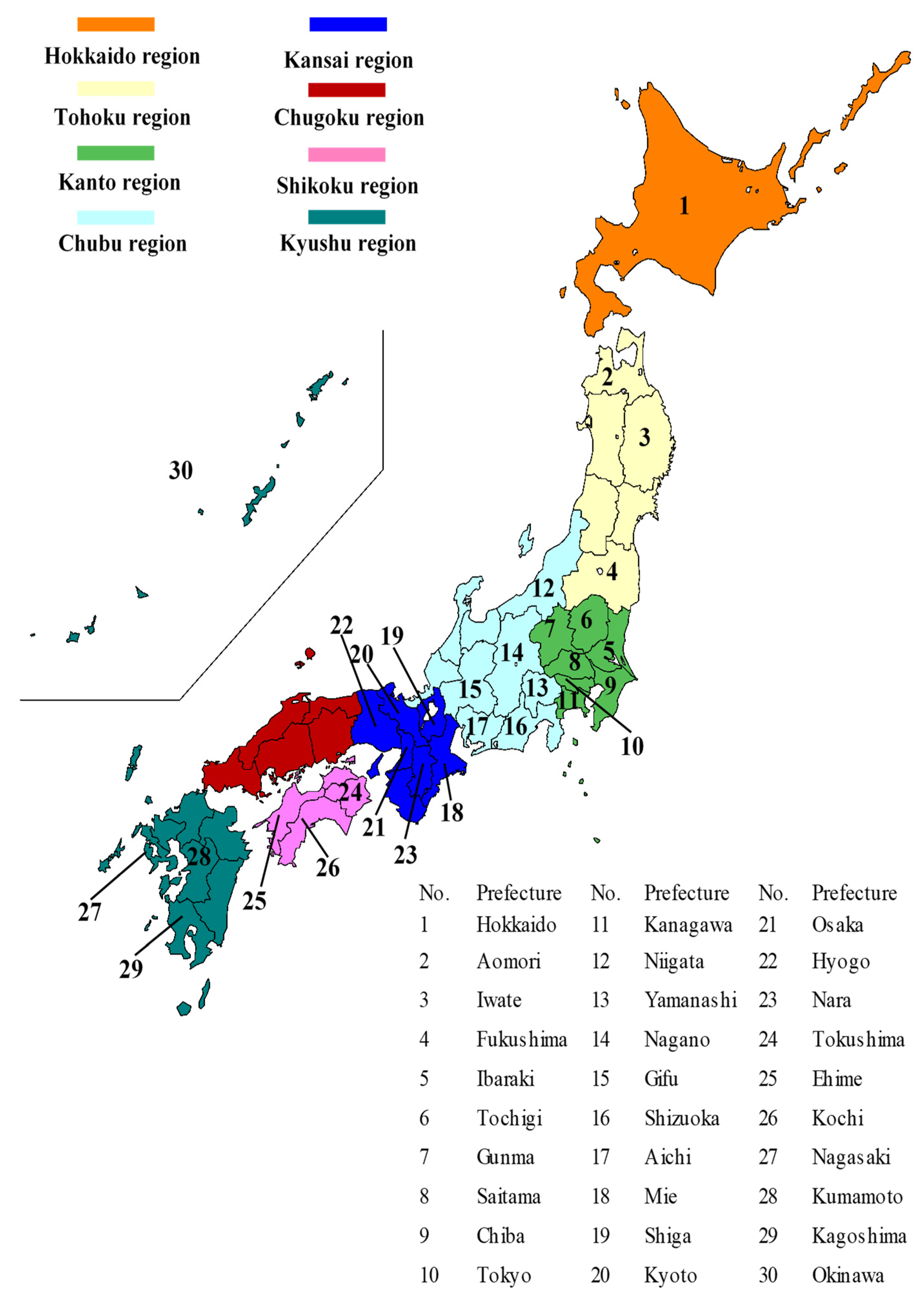



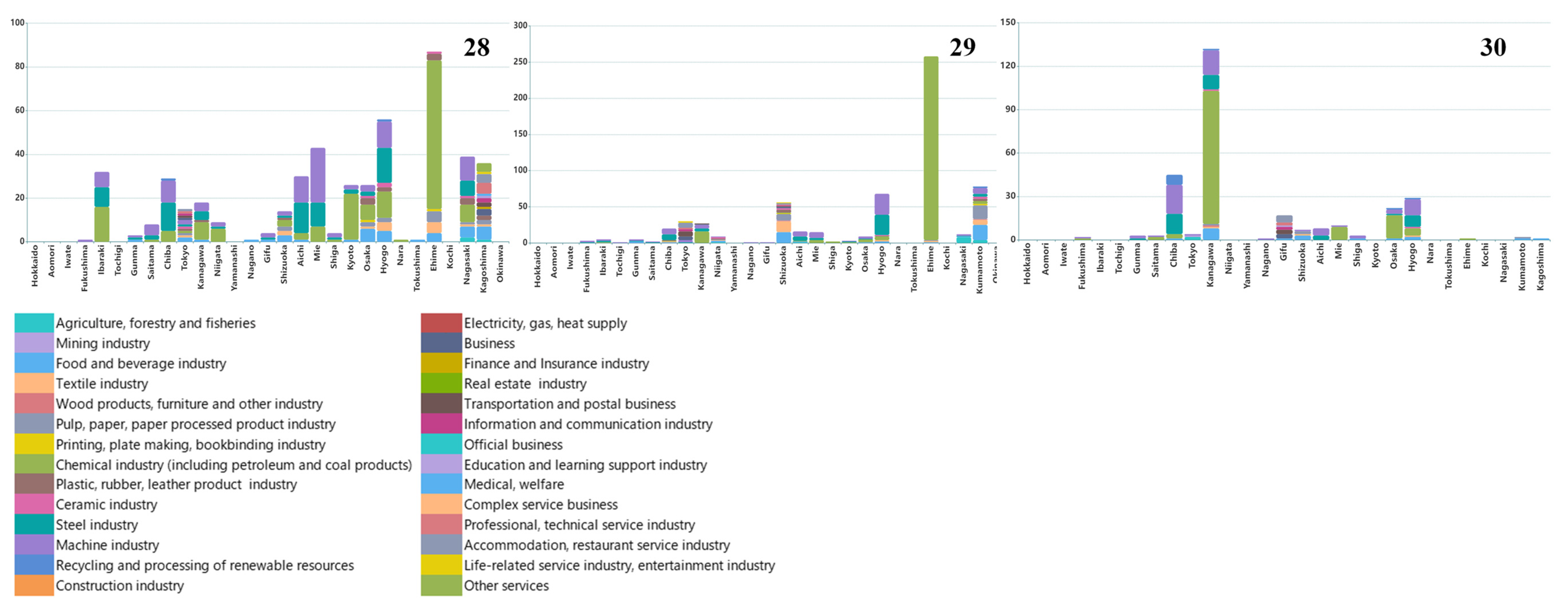
| Prefecture | Percentage | Prefecture | Percentage |
|---|---|---|---|
| Hokkaido | 89.57% | Shizuoka | 95.82% |
| Aomori | 82.14% | Aichi | 88.11% |
| Iwate | 37.67% | Mie | 95.51% |
| Fukushima | 61.05% | Shiga | 94.01% |
| Ibaraki | 97.58% | Kyoto | 93.30% |
| Tochigi | 96.79% | Osaka | 85.88% |
| Gunma | 98.13% | Hyogo | 74.60% |
| Saitama | 97.71% | Nara | 92.43% |
| Chiba | 98.54% | Tokushima | 48.46% |
| Tokyo | 98.29% | Ehime | 27.62% |
| Kanagawa | 97.71% | Kochi | 71.14% |
| Niigata | 86.54% | Nagasaki | 30.26% |
| Yamanashi | 96.84% | Kumamoto | 15.57% |
| Nagano | 94.33% | Kagoshima | 19.86% |
| Gifu | 95.52% | Okinawa | 45.97% |
| Weighted average | 92.98% | ||
| No. | Sector | No. | Sector |
|---|---|---|---|
| 1 | Agriculture, Forestry, and Fishery | 15 | Electricity, Gas, Heat Supply, and Water |
| 2 | Mining, Quarrying of Stone and Gravel | 16 | Wholesale and Retail Trade |
| 3 | Food, Beverages, Tobacco, and Feed | 17 | Finance and Insurance |
| 4 | Textile Mill Products | 18 | Real Estate and Goods Rental and Leasing |
| 5 | Lumber, Wood Products, Furniture, and Fixtures | 19 | Transport and Postal Activities |
| 6 | Pulp, Paper, and Paper Products | 20 | Information and Communications |
| 7 | Printing and Allied Industries | 21 | Government |
| 8 | Chemical and Allied Products, Oil and Coal Products | 22 | Education, Learning Support |
| 9 | Plastic Products, Rubber Products, and Leather Products | 23 | Medical, Health Care, and Welfare |
| 10 | Ceramic, Stone, and Clay Products | 24 | Compound Services |
| 11 | Iron and Steel | 25 | Scientific Research, Professional and Technical Services |
| 12 | Machinery | 26 | Accommodation, Eating and Drinking Services |
| 13 | Miscellaneous Manufacturing Industry | 27 | Living Related and Personal Services and Amusement Services |
| 14 | Construction Work Industry | 28 | Miscellaneous Services |
| No. | Sector | No. | Sector | ||
|---|---|---|---|---|---|
| Agricultural, marine, and forest products | 1 | Agriculture, forestry, and fisheries | Special product | Electricity, gas, heat, and water supply | |
| Mining products | 2 | Mining industry | 16 | Business | |
| Light industrial products | 3 | Food and beverage industry | 17 | Finance and Insurance industry | |
| 4 | Textile industry | 18 | Real estate industry | ||
| 5 | Wood products, furniture, and other industry | 19 | Transportation and postal business | ||
| 6 | Pulp, paper, paper processed product industry | 20 | Information and communication industry | ||
| 7 | Printing, plate making, bookbinding industry | 21 | Official business | ||
| 8 | Plastic, rubber, leather product industry | 22 | Education and learning support industry | ||
| 9 | Ceramic industry | 23 | Medical, welfare | ||
| Chemical products | 10 | Chemical industry (including petroleum and coal products) | 24 | Complex service business | |
| Metal machinery products | 11 | Steel industry | 25 | Professional, technical service industry | |
| 12 | Machine industry | 26 | Accommodation, restaurant service industry | ||
| Industrial waste | 13 | Recycling and processing of renewable resources | 27 | Life-related service industry, entertainment industry | |
| Miscellaneous manufactured products | 14 | Construction industry | 28 | Other services |
References
- Crippa, M.; Oreggioni, G.; Guizzardi, D.; Muntean, M.; Schaaf, E.; Lo Vullo, E.; Solazzo, E.; Monforti-Ferrario, F.; Olivier, J.; Vignati, E. Fossil CO2 & GHG Emissions of All World Countries; Publications Office of the European Union: Luxembourg, 2019; ISBN 9789276110255. [Google Scholar]
- Climate Change Convention. GHG Time Series Data from UNFCCC. 2019. Available online: https://di.unfccc.int/time_series (accessed on 26 March 2021).
- Ministry of Economy, Trade and Industry. White Paper on Manufacturing Infrastructure. 2015. Available online: https://www.meti.go.jp/report/whitepaper/mono/2015/honbun_pdf/index.html (accessed on 10 March 2021).
- National Institute for Environmental Studies. The GHG Emissions Data of Japan. 2020. Available online: https://www.nies.go.jp/gio/archive/ghgdata/index.html (accessed on 13 March 2021).
- Jiang, Y.; Cai, W.; Wan, L.; Wang, C. An index decomposition analysis of China’s interregional embodied carbon flows. J. Clean. Prod. 2015, 88, 289–296. [Google Scholar] [CrossRef]
- Cabinet Office of Japanese Government. The Regional Economy of 2011. 2011. Available online: https://www5.cao.go.jp/j-j/cr/cr11/chr11_index.html (accessed on 10 June 2022).
- Cabinet Office of Japanese Government. Prefectural Economic Calculation. 2015. Available online: https://www.esri.cao.go.jp/jp/sna/data/data_list/kenmin/files/contents/main_h26.html (accessed on 10 June 2022).
- Furukawa, S. Local Decentralization in Japan. Local Gov. Law J. 2010, 10, 35–63. [Google Scholar] [CrossRef]
- Wang, Y.; Xiong, S.; Ma, X. Carbon inequality in global trade: Evidence from the mismatch between embodied carbon emissions and value added. Ecol. Econ. 2022, 195, 107398. [Google Scholar] [CrossRef]
- Jiang, L.; He, S.; Tian, X.; Zhang, B.; Zhou, H. Energy use embodied in international trade of 39 countries: Spatial transfer patterns and driving factors. Energy 2020, 195, 116988. [Google Scholar] [CrossRef]
- Wang, Q.; Zhou, Y. Imbalance of carbon emissions embodied in the US-Japan trade: Temporal change and driving factors. J. Clean. Prod. 2019, 237, 117780. [Google Scholar] [CrossRef]
- Dou, Y.; Zhao, J.; Malik, M.N.; Dong, K. Assessing the impact of trade openness on CO2 emissions: Evidence from China-Japan-ROK FTA countries. J. Environ. Manag. 2021, 296, 113241. [Google Scholar] [CrossRef]
- Yoon, Y.; Kim, Y.K.; Kim, J. Embodied CO2 emission changes in manufacturing trade: Structural decomposition analysis of China, Japan, and Korea. Atmosphere 2020, 11, 597. [Google Scholar] [CrossRef]
- Battuvshin, B.; Matsuoka, Y.; Shirasawa, H.; Toyama, K.; Hayashi, U.; Aruga, K. Supply potential and annual availability of timber and forest biomass resources for energy considering inter-prefectural trade in Japan. Land Use Policy 2020, 97, 104780. [Google Scholar] [CrossRef]
- Sadayuki, T.; Arimura, T.H. Do regional emission trading schemes lead to carbon leakage within firms? Evidence from Japan. Energy Econ. 2021, 104, 105664. [Google Scholar] [CrossRef]
- Wu, X.D.; Guo, J.L.; Li, C.; Chen, G.Q.; Ji, X. Carbon emissions embodied in the global supply chain: Intermediate and final trade imbalances. Sci. Total Environ. 2020, 707, 134670. [Google Scholar] [CrossRef]
- Wang, Q.; Zhou, Y. Uncovering embodied CO2 flows via North-North trade–A case study of US-Germany trade. Sci. Total Environ. 2019, 691, 943–959. [Google Scholar] [CrossRef] [PubMed]
- Kim, T.J.; Tromp, N. Analysis of carbon emissions embodied in South Korea’s international trade: Production-based and consumption-based perspectives. J. Clean. Prod. 2021, 320, 128839. [Google Scholar] [CrossRef]
- Tian, K.; Zhang, Y.; Li, Y.; Ming, X.; Jiang, S.; Duan, H.; Yang, C.; Wang, S. Regional trade agreement burdens global carbon emissions mitigation. Nat. Commun. 2022, 13, 1–12. [Google Scholar] [CrossRef] [PubMed]
- Wang, Q.; Yang, X. Imbalance of carbon embodied in South-South trade: Evidence from China-India trade. Sci. Total Environ. 2020, 707, 134473. [Google Scholar] [CrossRef]
- Kim, T.J.; Tromp, N. Carbon emissions embodied in China-Brazil trade: Trends and driving factors. J. Clean. Prod. 2021, 293, 126206. [Google Scholar] [CrossRef]
- Liu, H.; Zong, Z.; Hynes, K.; De Bruyne, K. Can China reduce the carbon emissions of its manufacturing exports by moving up the global value chain? Res. Int. Bus. Financ. 2020, 51, 101101. [Google Scholar] [CrossRef]
- Wang, S.; Zhao, Y.; Wiedmann, T. Carbon emissions embodied in China–Australia trade: A scenario analysis based on input–output analysis and panel regression models. J. Clean. Prod. 2019, 220, 721–731. [Google Scholar] [CrossRef]
- Wang, Q.; Liu, Y.; Wang, H. Determinants of net carbon emissions embodied in Sino-German trade. J. Clean. Prod. 2019, 235, 1216–1231. [Google Scholar] [CrossRef]
- Wang, Q.; Han, X. Is decoupling embodied carbon emissions from economic output in Sino-US trade possible? Technol. Forecast. Soc. Chang. 2021, 169, 120805. [Google Scholar] [CrossRef]
- Wu, R.; Geng, Y.; Dong, H.; Fujita, T.; Tian, X. Changes of CO2 emissions embodied in China-Japan trade: Drivers and implications. J. Clean. Prod. 2016, 112, 4151–4158. [Google Scholar] [CrossRef]
- Zhao, Y.; Wang, S.; Yang, J.; Zhang, Z.; Liu, Y. Input-output analysis of carbon emissions embodied in China-Japan trade. Appl. Econ. 2016, 48, 1515–1529. [Google Scholar] [CrossRef]
- Long, R.; Li, J.; Chen, H.; Zhang, L.; Li, Q. Embodied carbon dioxide flow in international trade: A comparative analysis based on China and Japan. J. Environ. Manag. 2018, 209, 371–381. [Google Scholar] [CrossRef] [PubMed]
- Xu, D.; Zhang, Y.; Chen, B.; Bai, J.; Liu, G.; Zhang, B. Identifying the critical paths and sectors for carbon transfers driven by global consumption in 2015. Appl. Energy 2022, 306, 118137. [Google Scholar] [CrossRef]
- Xu, D.; Zhang, Y.; Li, Y.; Wang, X.; Yang, Z. Path analysis for carbon transfers embodied in China’s international trade and policy implications for mitigation targets. J. Clean. Prod. 2022, 334, 130207. [Google Scholar] [CrossRef]
- Zhou, D.; Zhou, X.; Xu, Q.; Wu, F.; Wang, Q.; Zha, D. Regional embodied carbon emissions and their transfer characteristics in China. Struct. Chang. Econ. Dyn. 2018, 46, 180–193. [Google Scholar] [CrossRef]
- Wei, W.; Hao, S.; Yao, M.; Chen, W.; Wang, S.; Wang, Z.; Wang, Y.; Zhang, P. Unbalanced economic benefits and the electricity-related carbon emissions embodied in China’s interprovincial trade. J. Environ. Manag. 2020, 263, 110390. [Google Scholar] [CrossRef]
- Wang, W.; Hu, Y. The measurement and influencing factors of carbon transfers embodied in inter-provincial trade in China. J. Clean. Prod. 2020, 270, 122460. [Google Scholar] [CrossRef]
- Yi, I.; Itsubo, N.; Inaba, A.; Matsumoto, K. Development of the interregional I/O based LCA method considering region-specifics of indirect effects in regional evaluation. Int. J. Life Cycle Assess. 2007, 12, 353–364. [Google Scholar] [CrossRef]
- Hasegawa, R.; Kagawa, S.; Tsukui, M. Carbon footprint analysis through constructing a multi-region input–output table: A case study of Japan. J. Econ. Struct. 2015, 4. [Google Scholar] [CrossRef] [Green Version]
- Lin, B.; Xie, X. CO2 emissions of China’s food industry: An input-output approach. J. Clean. Prod. 2016, 112, 1410–1421. [Google Scholar] [CrossRef]
- Leontief, W. Environmental Repercussions and the Economic Structure: An Input-Output Approach. Rev. Econ. Stat. 1970, 52, 262. [Google Scholar] [CrossRef]
- He, H.; Reynolds, C.J.; Li, L.; Boland, J. Assessing net energy consumption of Australian economy from 2004–05 to 2014–15: Environmentally-extended input-output analysis, structural decomposition analysis, and linkage analysis. Appl. Energy 2019, 240, 766–777. [Google Scholar] [CrossRef]
- Wakiyama, T.; Lenzen, M.; Geschke, A.; Bamba, R.; Nansai, K. A flexible multiregional input–output database for city-level sustainability footprint analysis in Japan. Resour. Conserv. Recycl. 2020, 154, 104588. [Google Scholar] [CrossRef]
- Agency for Natural Resources and Energy. Energy Consumption Statistics by Prefecture 2021. Available online: https://www.enecho.meti.go.jp/statistics/energy_consumption/ec002/results.html#headline2 (accessed on 27 October 2021).
- Ministry of Land Infrastructure Transport and Tourism. National Cargo Net Flow Survey. 2016. Available online: https://www.mlit.go.jp/sogoseisaku/transport/butsuryu06100.html (accessed on 10 March 2021).
- Japan Center for Climate Change Actions. Trends in Carbon Dioxide Emissions by Sector in Japan (1990–2019). 2021. Available online: https://www.jccca.org/download/13336?p_page=3#search (accessed on 27 January 2022).
- Matsumoto, K.; Shigetomi, Y.; Shiraki, H.; Ochi, Y.; Ogawa, Y.; Ehara, T. Addressing key drivers of regional CO2 emissions of the manufacturing industry in Japan. Energy J. 2019, 40, 3–8. [Google Scholar] [CrossRef]
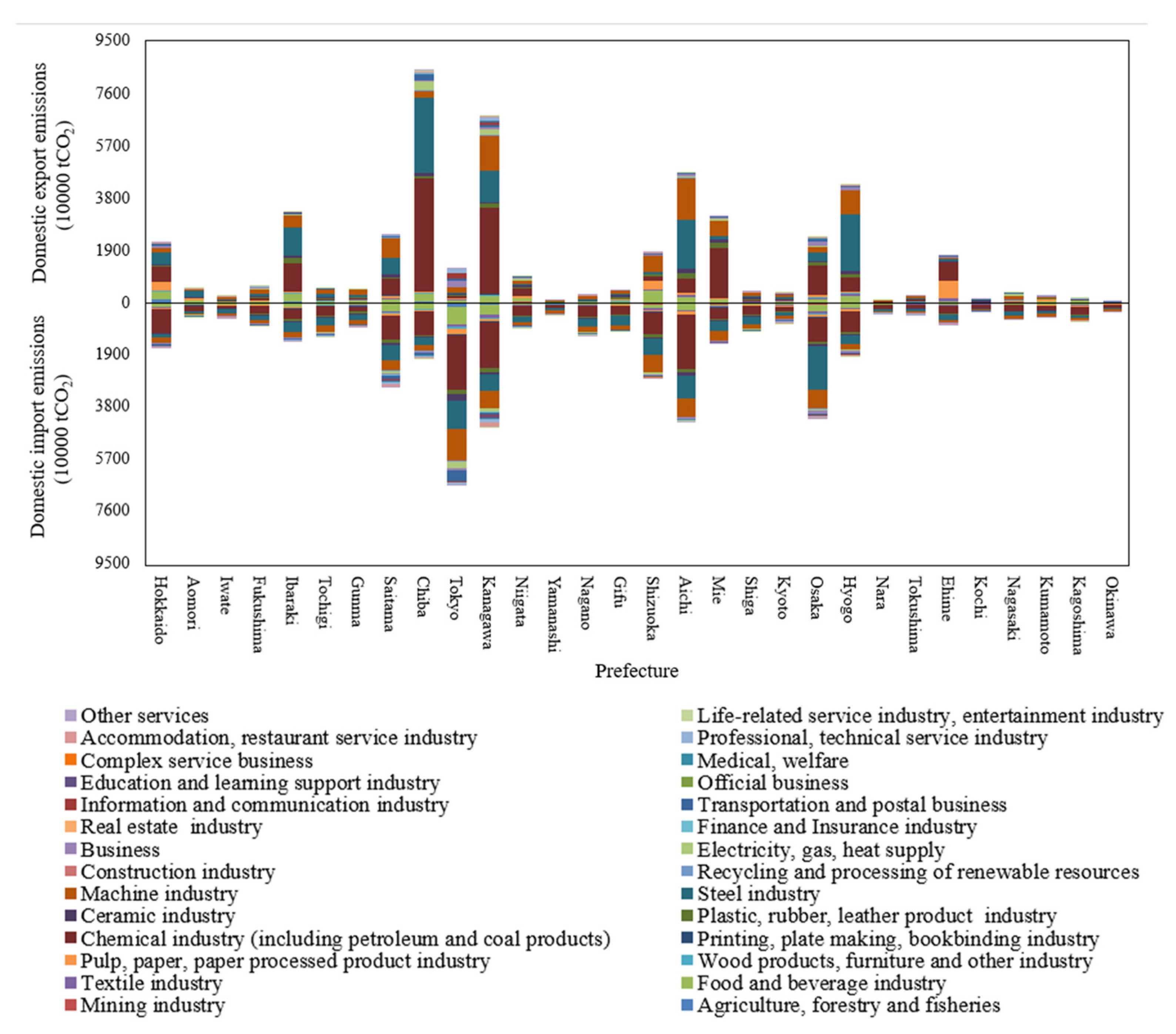
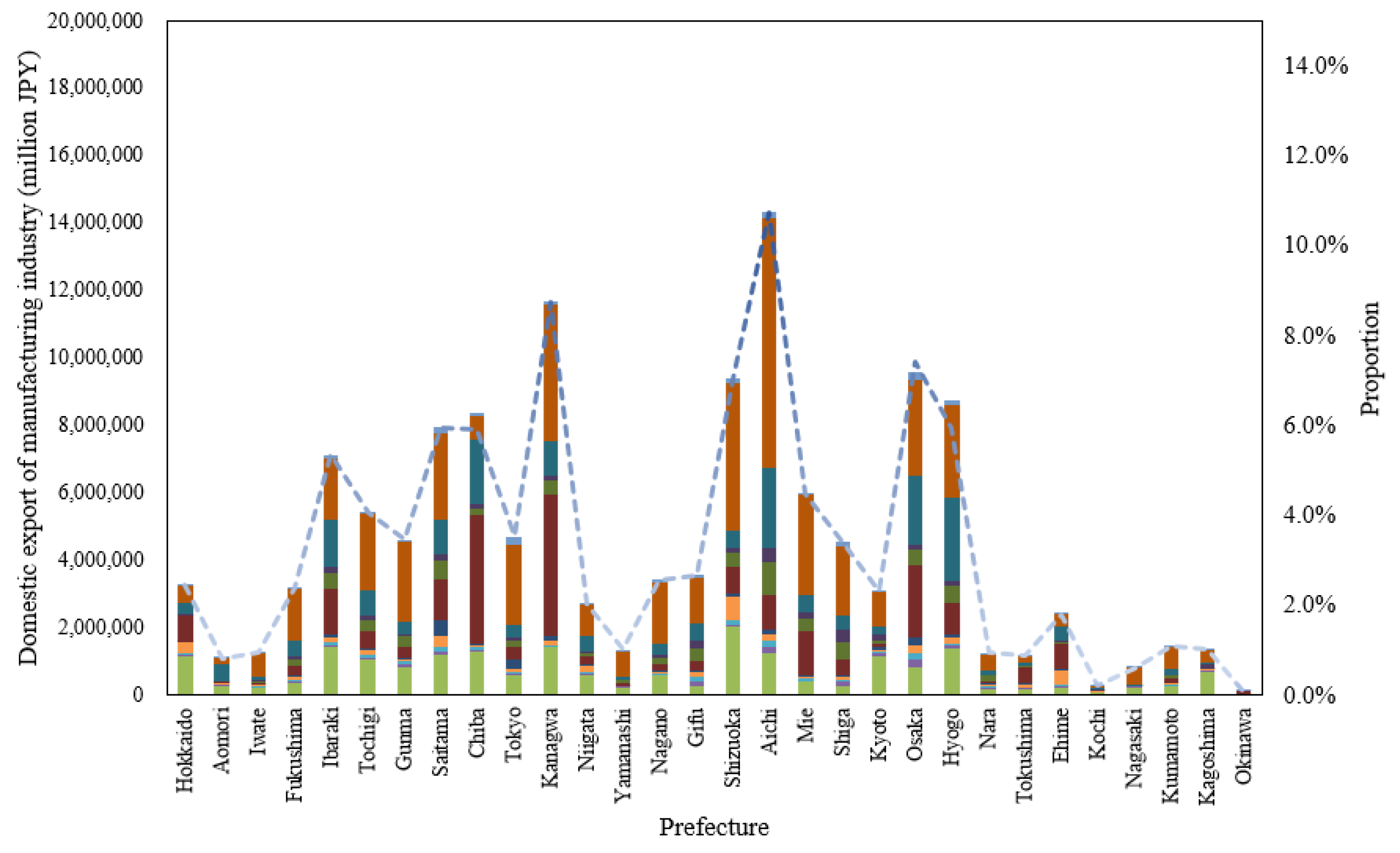

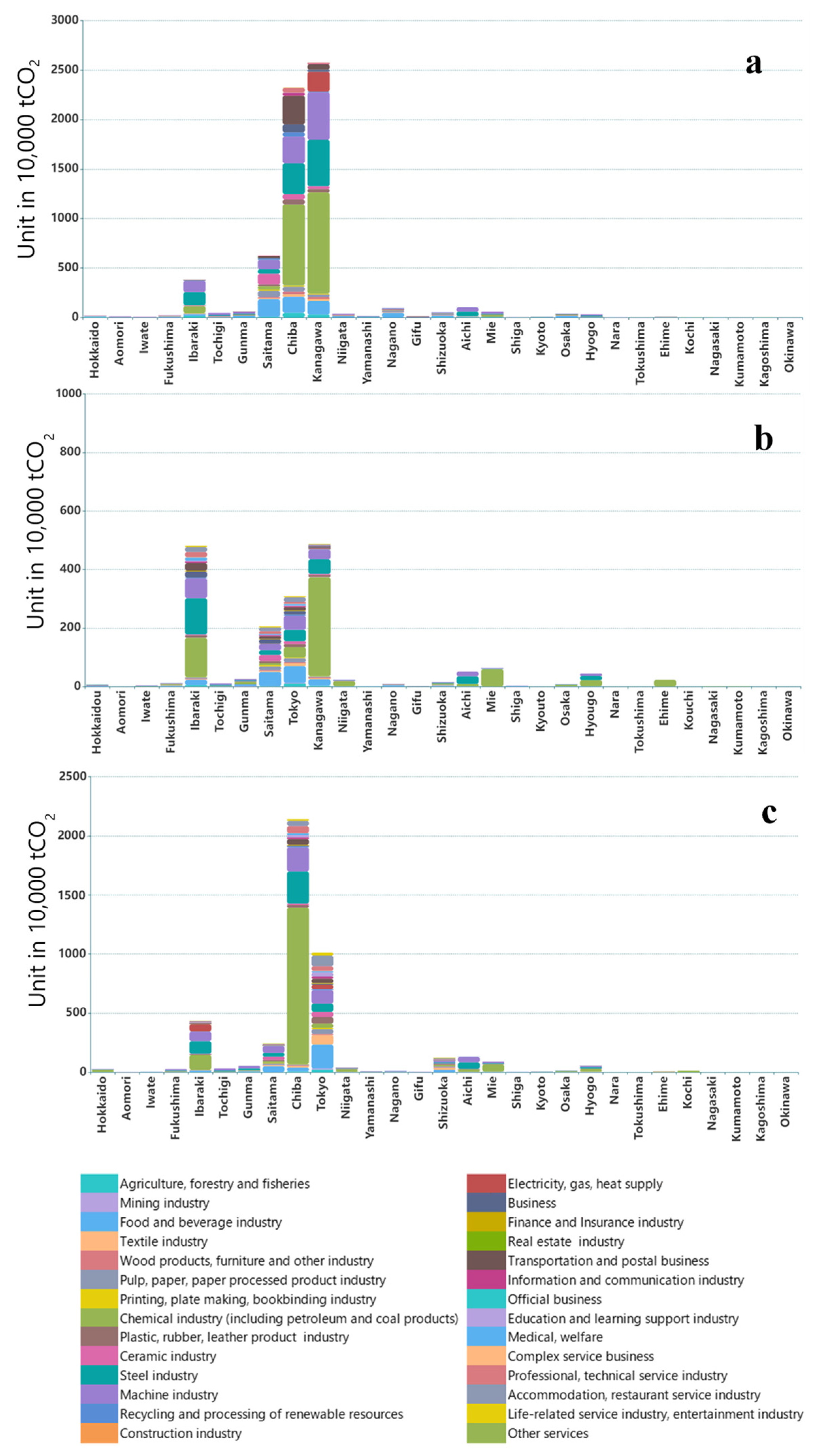
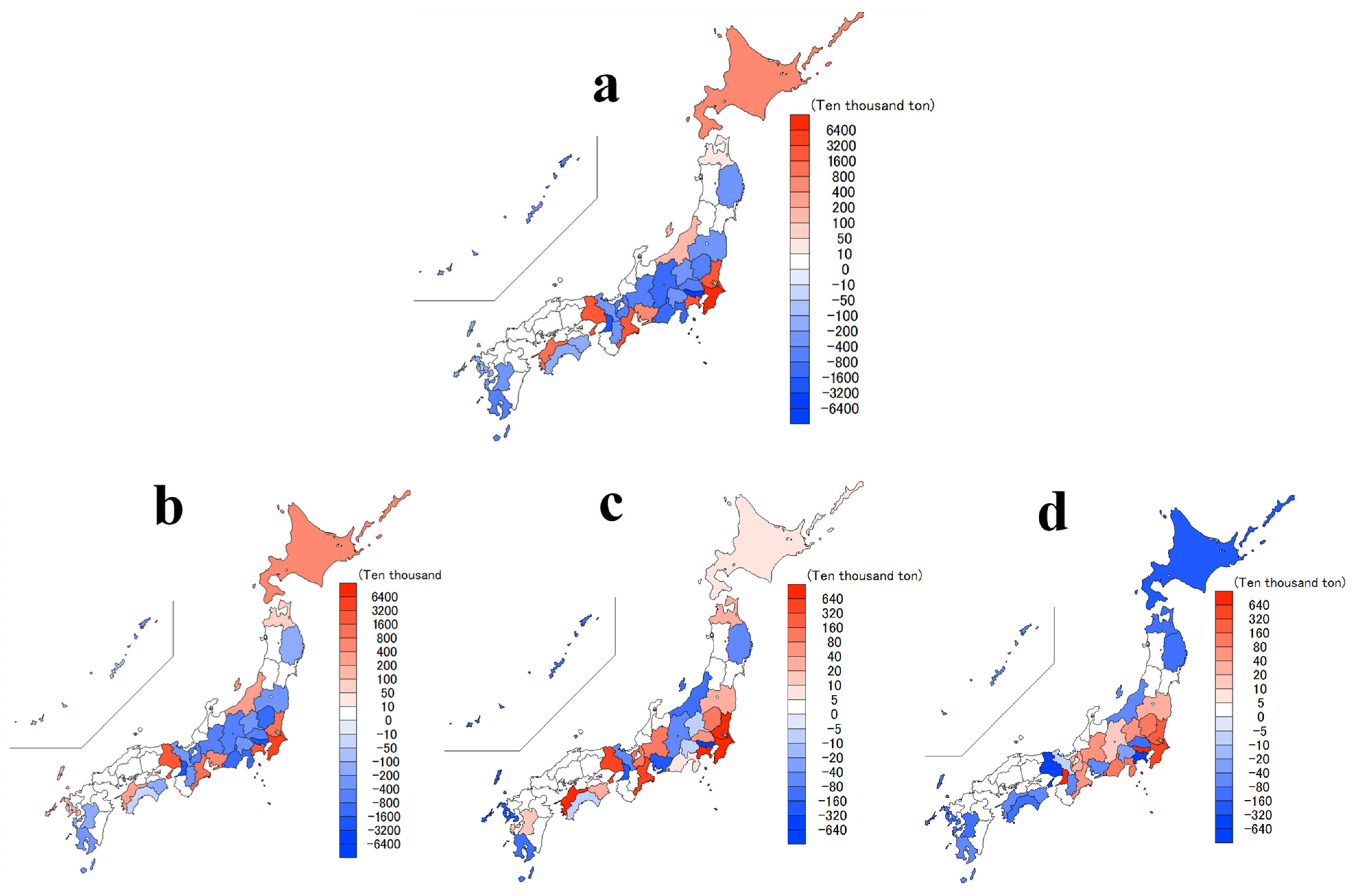
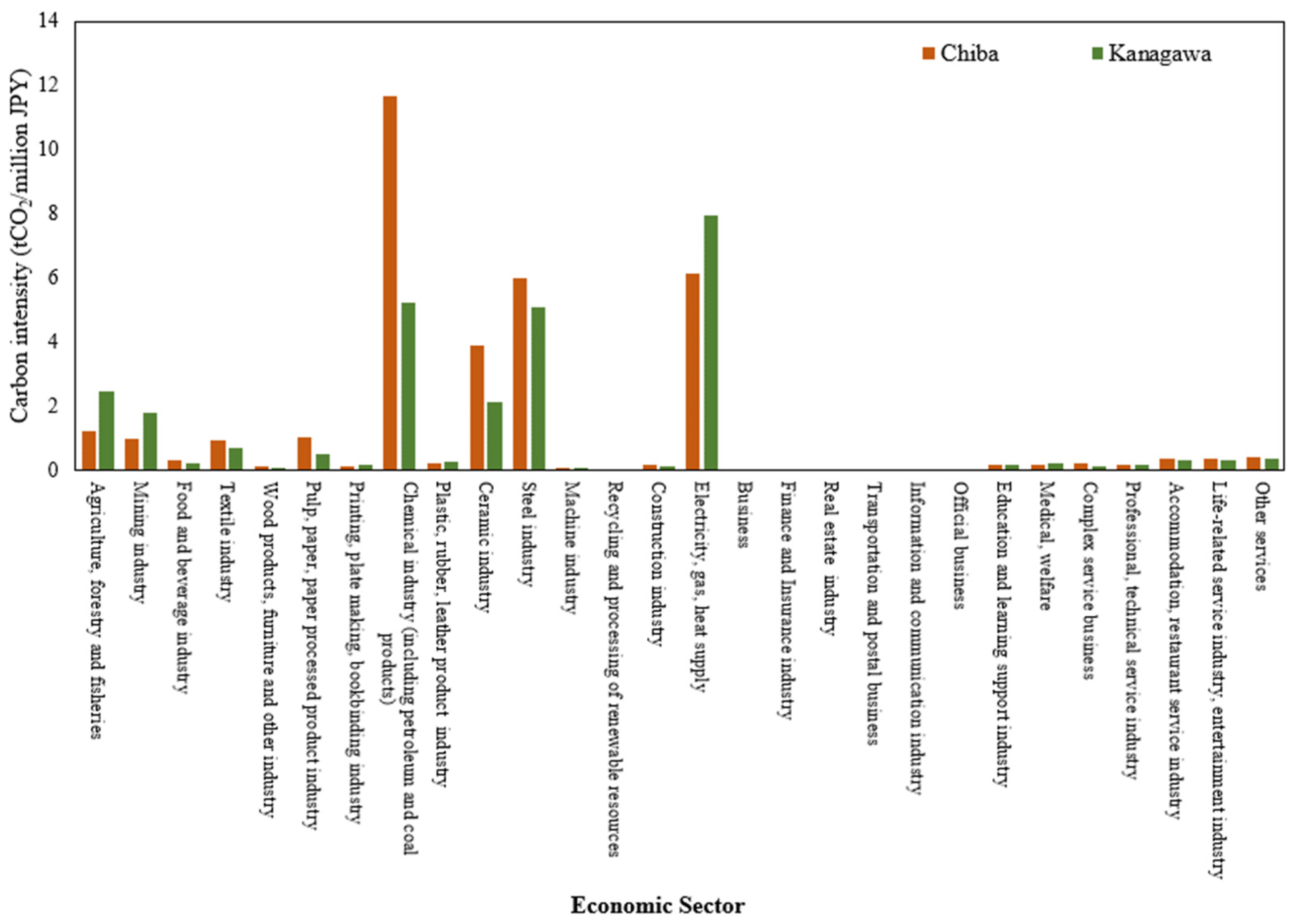
Publisher’s Note: MDPI stays neutral with regard to jurisdictional claims in published maps and institutional affiliations. |
© 2022 by the authors. Licensee MDPI, Basel, Switzerland. This article is an open access article distributed under the terms and conditions of the Creative Commons Attribution (CC BY) license (https://creativecommons.org/licenses/by/4.0/).
Share and Cite
Huang, Y.; Matsumoto, K. Estimation of CO2 Emissions Embodied in Domestic Trade and Their Influencing Factors in Japan. Sustainability 2022, 14, 8498. https://doi.org/10.3390/su14148498
Huang Y, Matsumoto K. Estimation of CO2 Emissions Embodied in Domestic Trade and Their Influencing Factors in Japan. Sustainability. 2022; 14(14):8498. https://doi.org/10.3390/su14148498
Chicago/Turabian StyleHuang, Yuzhuo, and Ken’ichi Matsumoto. 2022. "Estimation of CO2 Emissions Embodied in Domestic Trade and Their Influencing Factors in Japan" Sustainability 14, no. 14: 8498. https://doi.org/10.3390/su14148498
APA StyleHuang, Y., & Matsumoto, K. (2022). Estimation of CO2 Emissions Embodied in Domestic Trade and Their Influencing Factors in Japan. Sustainability, 14(14), 8498. https://doi.org/10.3390/su14148498






